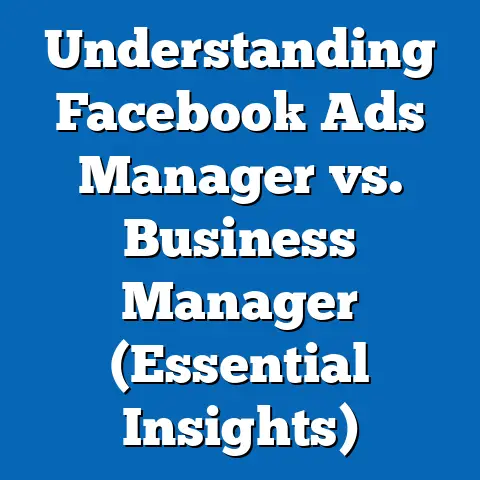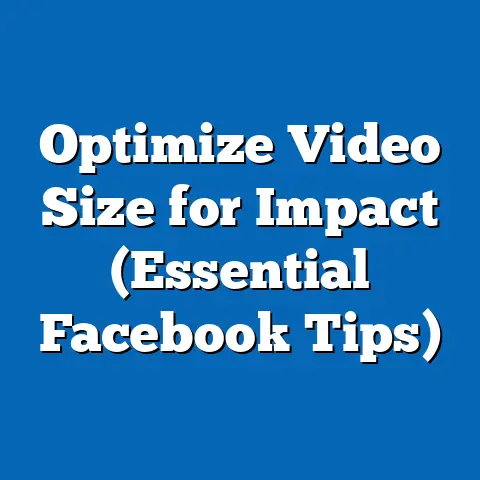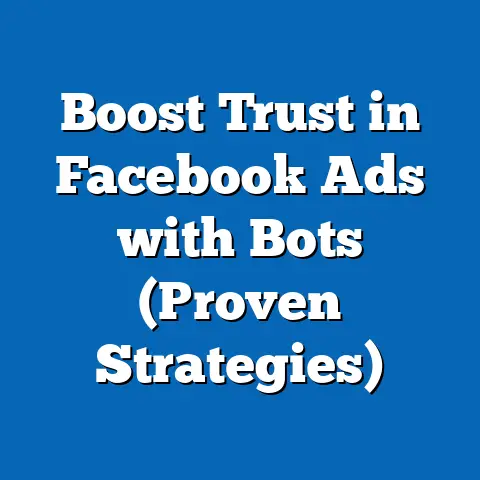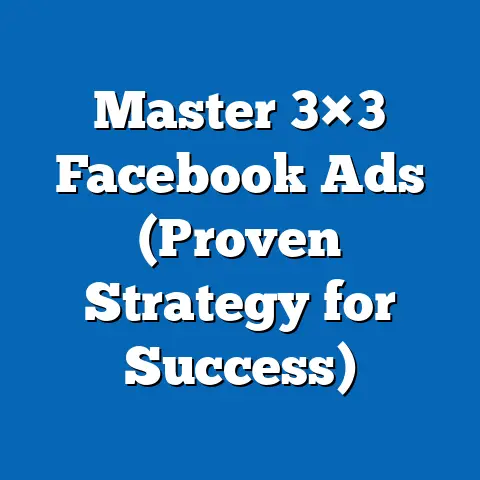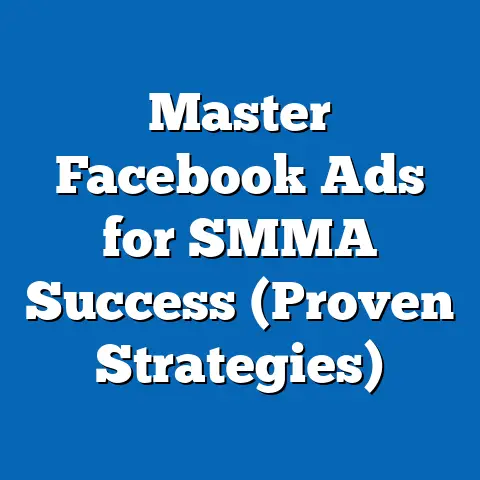Control Facebook Ads Posting (Powerful Tactics Explained)
Why don’t marketers play hide and seek? Because good luck hiding when they can find you through targeted ads! In today’s digital world, Facebook advertising is no longer a ‘nice-to-have’ but a necessity for businesses aiming to reach a vast and diverse audience. But simply throwing money at Facebook ads isn’t enough. The key to success lies in controlling your ad posting effectively.
I’ve spent years navigating the ever-changing landscape of Facebook ads, and I can tell you firsthand that taking control of your ad posting is a game-changer. It’s not just about setting up an ad and hoping for the best. It’s about strategically planning, executing, and optimizing your campaigns to achieve specific goals.
This article will delve into powerful tactics for controlling your Facebook ads posting, enabling you to enhance campaign performance, increase ROI, and boost audience engagement. I’ll guide you through the essentials, from understanding Facebook Ads basics to mastering advanced targeting techniques and creative control. Let’s dive in!
Section 1: Understanding Facebook Ads Basics
Facebook ads are a powerful tool that allows businesses of all sizes to connect with potential customers on the world’s largest social media platform. With billions of active users, Facebook offers unparalleled reach and targeting capabilities. But before you can effectively control your ad posting, you need a solid understanding of the fundamentals.
What are Facebook Ads?
Facebook ads are paid messages that businesses use to reach specific audiences on Facebook and Instagram. These ads can appear in various formats, including images, videos, carousels, and more. Unlike organic posts, ads are designed to reach users who may not already be following your page, expanding your potential customer base significantly.
Why are Facebook Ads Important?
- Vast Reach: Facebook boasts billions of active users, making it an ideal platform for reaching a large and diverse audience.
- Precise Targeting: Facebook’s advanced targeting options allow you to reach specific demographics, interests, and behaviors, ensuring your ads are seen by the most relevant users.
- Measurable Results: Facebook provides detailed analytics and reporting tools, allowing you to track the performance of your ads and make data-driven decisions.
- Cost-Effective: Compared to traditional advertising methods, Facebook ads can be a more cost-effective way to reach your target audience.
Different Types of Facebook Ads
Facebook offers a variety of ad formats to suit different marketing objectives. Here’s a brief overview:
- Image Ads: Simple yet effective, image ads are ideal for showcasing products or services with visually appealing imagery.
- Video Ads: Engage your audience with dynamic video content, perfect for storytelling and product demonstrations.
- Carousel Ads: Display multiple images or videos in a single ad unit, allowing users to scroll through different offerings.
- Collection Ads: Showcase a selection of products in a visually immersive format, ideal for e-commerce businesses.
- Lead Ads: Capture leads directly within Facebook, making it easy for potential customers to provide their contact information.
Each ad type has its unique advantages. I’ve found that video ads often outperform static images when aiming for engagement, while carousel ads are fantastic for showcasing multiple products. Your choice should align with your campaign goals and target audience preferences.
The Facebook Ads Manager: Your Control Center
The Facebook Ads Manager is the central hub for creating, managing, and tracking your Facebook ad campaigns. It provides a comprehensive interface for:
- Creating Campaigns: Define your campaign objective, target audience, budget, and schedule.
- Designing Ads: Choose your ad format, upload visuals, and write compelling ad copy.
- Setting Bids: Determine how much you’re willing to pay for each ad interaction (e.g., clicks, impressions).
- Monitoring Performance: Track key metrics and analyze the performance of your ads in real-time.
I remember when I first started using Ads Manager, it felt overwhelming. But with practice, it becomes second nature. Take the time to explore all the features and familiarize yourself with the interface.
Key Terms and Metrics
Understanding key terms and metrics is crucial for controlling your ad posting effectively. Here are some essential ones:
- CPC (Cost Per Click): The amount you pay each time someone clicks on your ad.
- CPM (Cost Per Mille): The amount you pay for every 1,000 impressions (times your ad is shown).
- CTR (Click-Through Rate): The percentage of people who see your ad and click on it.
- Reach: The number of unique people who saw your ad.
- Impressions: The total number of times your ad was displayed.
- Conversion Rate: The percentage of people who complete a desired action (e.g., purchase, sign-up) after clicking on your ad.
Takeaway: Understanding the basics of Facebook ads, including the different ad types, the Ads Manager interface, and key metrics, is essential for effectively controlling your ad posting and achieving your marketing goals.
Section 2: Setting Clear Goals for Your Ads
Before you even think about creating your ads, you need to define what you want to achieve. Setting clear, specific goals is the foundation of any successful Facebook ad campaign. Without a clear objective, you’re essentially driving without a destination.
The Importance of SMART Goals
I’m a big believer in the SMART framework. It’s a simple yet powerful way to ensure your goals are well-defined and achievable. SMART stands for:
- Specific: Clearly define what you want to achieve. Instead of “increase website traffic,” try “increase website traffic by 20%.”
- Measurable: Establish metrics to track your progress. How will you know if you’ve achieved your goal?
- Achievable: Set realistic goals that are within your reach. Don’t aim for the impossible.
- Relevant: Ensure your goals align with your overall business objectives.
- Time-bound: Set a deadline for achieving your goals. This creates a sense of urgency and keeps you on track.
Examples of Different Types of Goals
- Brand Awareness: Increase awareness of your brand among a specific target audience. This could involve increasing reach, impressions, and engagement.
- Lead Generation: Collect leads from potential customers. This could involve using lead ads or driving traffic to a landing page with a sign-up form.
- Sales Conversion: Drive sales of your products or services. This could involve using product ads or driving traffic to your e-commerce store.
- Website Traffic: Increase traffic to your website. This could involve using link ads or driving traffic to specific blog posts or product pages.
- App Installs: Encourage users to download your mobile app. This could involve using app install ads.
Aligning Ad Content and Posting Times with Your Goals
Once you’ve defined your goals, you need to align your ad content and posting times accordingly. For example:
- Brand Awareness: Focus on visually appealing content that showcases your brand’s personality and values. Post during peak hours when your target audience is most active.
- Lead Generation: Use compelling ad copy that highlights the benefits of providing their contact information. Offer a valuable incentive, such as a free e-book or discount code.
- Sales Conversion: Showcase your products or services with high-quality images and videos. Use persuasive ad copy that highlights the value proposition. Target users who are most likely to make a purchase.
I once worked on a campaign for a local bakery that aimed to increase brand awareness. We focused on creating mouth-watering images of their pastries and posting them during breakfast and lunch hours. The result? A significant increase in foot traffic and online orders.
Takeaway: Setting SMART goals for your Facebook ad campaigns is crucial for success. Align your ad content and posting times with your goals to maximize impact and achieve your desired outcomes.
Section 3: Audience Targeting Techniques
Imagine walking into a crowded stadium and shouting a message hoping the right person hears it. That’s what advertising without proper targeting feels like. It’s inefficient, expensive, and unlikely to yield the results you want.
Precise audience targeting is the cornerstone of effective Facebook advertising. It allows you to reach the right people with the right message at the right time, maximizing your ROI and minimizing wasted ad spend. I can’t stress enough how important this is.
Different Targeting Options Available
Facebook offers a wide range of targeting options to help you reach your ideal audience:
- Demographics: Target users based on age, gender, location, education, relationship status, and more.
- Interests: Target users based on their interests and hobbies, as expressed through their Facebook activity.
- Behaviors: Target users based on their online and offline behaviors, such as purchase history, device usage, and travel habits.
- Custom Audiences: Target users based on your own customer data, such as email lists, website visitors, and app users.
- Lookalike Audiences: Target users who are similar to your existing customers, expanding your reach while maintaining relevance.
Advanced Targeting Strategies
- Retargeting: Target users who have previously interacted with your business, such as website visitors or app users. This is a highly effective way to re-engage potential customers and drive conversions.
- Segmentation: Divide your audience into smaller, more specific segments based on shared characteristics. This allows you to tailor your ad messaging to each segment, increasing relevance and engagement.
Case Studies and Examples
I once worked with an e-commerce store that sold eco-friendly products. We used a combination of interest-based targeting (e.g., users interested in sustainable living, environmentalism) and custom audiences (e.g., website visitors who viewed specific product pages). By segmenting our audience and tailoring our ad messaging to each segment, we were able to significantly increase sales and ROI.
Tips for Effective Audience Targeting
- Know Your Audience: Conduct thorough research to understand your target audience’s demographics, interests, and behaviors.
- Test Different Targeting Options: Experiment with different targeting options to see what works best for your business.
- Refine Your Targeting Over Time: Continuously monitor the performance of your ads and refine your targeting based on the data you collect.
Takeaway: Precise audience targeting is essential for maximizing the effectiveness of your Facebook ad campaigns. Leverage the various targeting options available and experiment with advanced strategies like retargeting and segmentation to reach the right people with the right message.
Section 4: Timing and Frequency of Ad Posts
Imagine serving a delicious meal at the wrong time – say, breakfast for dinner. It might be good food, but the timing is off. The same principle applies to Facebook ads. Timing and frequency can significantly impact your ad performance. Reaching your audience when they’re most receptive is crucial.
Best Practices for Scheduling Facebook Ads
- Identify Peak Activity Times: Use Facebook Insights to determine when your target audience is most active on the platform.
- Consider Time Zones: If you’re targeting a global audience, be mindful of different time zones.
- Test Different Scheduling Options: Experiment with different posting times to see what works best for your business.
I often advise clients to start by mirroring their organic posting schedule for ads, then adjust based on performance data.
How Timing Affects Ad Performance
The timing of your ad posts can significantly impact their performance. For example:
- Reaching your audience when they are most active: Posting during peak hours ensures your ads are seen by more people.
- Considering the context of your ads: If you’re promoting a lunch special, posting during lunchtime is a no-brainer.
- Aligning your ads with relevant events: If you’re running a holiday promotion, be sure to start your ads well in advance of the holiday.
Ad Fatigue and Frequency Management
Ad fatigue occurs when your audience becomes tired of seeing the same ads repeatedly. This can lead to decreased engagement and lower click-through rates. Here’s how to manage ad frequency:
- Rotate Your Ads: Regularly update your ad creatives and messaging to keep things fresh.
- Use Frequency Capping: Limit the number of times each user sees your ad.
- Refine Your Targeting: Ensure you’re not over-targeting a small segment of your audience.
I’ve seen campaigns where simply changing the ad creative every few weeks revitalized engagement and lowered costs.
Using Facebook’s Ad Scheduling Tools and Insights
Facebook provides a variety of tools and insights to help you optimize your ad scheduling:
- Ad Scheduling: Schedule your ads to run at specific times of day or days of the week.
- Facebook Insights: Analyze the performance of your ads over time and identify trends in user activity.
- Delivery Optimization: Allow Facebook to automatically optimize your ad delivery based on your goals.
Takeaway: Timing and frequency are crucial factors in the success of your Facebook ad campaigns. Use Facebook’s scheduling tools and insights to optimize your posting times and manage ad frequency effectively.
Section 5: Creative Control Over Ad Content
Content is king, and in the realm of Facebook ads, the king needs to be well-dressed and articulate! You can have the perfect targeting and timing, but if your creative content falls flat, your campaign will suffer. Maintaining creative control over your ad content is essential for ensuring it resonates with your audience and drives results.
The Role of Creative Content in Facebook Ads
Creative content encompasses all the visual and textual elements of your ad, including:
- Images and Videos: High-quality visuals that capture attention and convey your message.
- Ad Copy: Compelling text that persuades users to take action.
- Headlines: Attention-grabbing headlines that draw users in.
- Call-to-Action (CTA): Clear and concise instructions that tell users what you want them to do.
I always tell my clients that their ad is their first impression. Make it count!
A/B Testing Different Creatives
A/B testing involves creating multiple versions of your ad with slight variations and testing them against each other to see which performs best. This is a powerful way to optimize your creative content and ensure it resonates with your audience.
- Test Different Headlines: Experiment with different headlines to see which ones generate the most clicks.
- Test Different Images: Try different images to see which ones capture the most attention.
- Test Different CTAs: Experiment with different CTAs to see which ones drive the most conversions.
Using Facebook’s Dynamic Ads Feature
Facebook’s dynamic ads feature allows you to automatically show the right products to the right people based on their browsing history and purchase behavior. This is a highly effective way to personalize your ads and increase sales.
For example, if a user visits your website and views a specific product, you can use dynamic ads to show them that product in a Facebook ad. This reminds them of their interest and encourages them to make a purchase.
Tips for Maintaining Brand Consistency
- Use Consistent Branding Elements: Use the same colors, fonts, and logos across all your ads.
- Maintain a Consistent Tone of Voice: Use a consistent tone of voice in your ad copy.
- Follow Your Brand Guidelines: Ensure your ads adhere to your brand’s style guide.
Takeaway: Creative content is a crucial element of successful Facebook ad campaigns. Maintain creative control over your ad content by A/B testing different creatives, using Facebook’s dynamic ads feature, and maintaining brand consistency.
Section 6: Monitoring and Analyzing Ad Performance
You’ve launched your ad campaign, your creative is on point, and you’ve targeted the right audience. Now what? The work doesn’t stop there. Monitoring and analyzing ad performance is crucial for understanding what’s working, what’s not, and how to optimize your campaigns for maximum ROI.
The Importance of Ongoing Monitoring and Analysis
Think of your ad campaigns as a living, breathing entity. They need constant attention and care. Ongoing monitoring and analysis allows you to:
- Identify Trends: Spot patterns in your data that can inform your future strategies.
- Optimize Your Campaigns: Make data-driven adjustments to improve performance.
- Maximize Your ROI: Ensure you’re getting the most out of your ad spend.
Key Metrics to Track and How They Influence Future Posting Strategies
- Reach and Impressions: These metrics tell you how many people are seeing your ads. If your reach is low, you may need to expand your targeting.
- Click-Through Rate (CTR): This metric measures the percentage of people who click on your ad after seeing it. A low CTR may indicate that your ad copy or creative isn’t compelling enough.
- Conversion Rate: This metric measures the percentage of people who complete a desired action after clicking on your ad. A low conversion rate may indicate that your landing page isn’t optimized for conversions.
- Cost Per Click (CPC): This metric measures the amount you pay each time someone clicks on your ad. A high CPC may indicate that your targeting is too broad or that your ad quality is low.
- Return on Ad Spend (ROAS): This metric measures the revenue you generate for every dollar you spend on ads. A high ROAS indicates that your ad campaigns are profitable.
Tools and Techniques for Analyzing Facebook Ad Performance
- Facebook Analytics: Facebook’s built-in analytics tool provides a wealth of data on your ad performance, including reach, impressions, CTR, conversion rate, and more.
- Third-Party Tools: There are many third-party tools available that can help you analyze your Facebook ad performance in more detail, such as Google Analytics, HubSpot, and SEMrush.
Adjusting Ad Campaigns Based on Performance Data
The key to controlling your ad posting effectively is to continuously adjust your campaigns based on performance data. This involves:
- Refining Your Targeting: Adjust your targeting options to reach a more relevant audience.
- Optimizing Your Creative: Experiment with different ad creatives and messaging to see what resonates best with your audience.
- Adjusting Your Bids: Adjust your bids to optimize your ad delivery and maximize your ROI.
- Pausing Underperforming Ads: Pause ads that aren’t performing well to avoid wasting ad spend.
Takeaway: Monitoring and analyzing ad performance is crucial for controlling your Facebook ad posting effectively. Track key metrics, use Facebook Analytics and third-party tools, and adjust your campaigns based on performance data to maximize your ROI.
Conclusion
In this article, I’ve explored powerful tactics for controlling your Facebook ads posting, from understanding the basics to mastering advanced targeting techniques and creative control. Remember, effective Facebook advertising is not a set-it-and-forget-it endeavor. It requires constant attention, analysis, and optimization.
By implementing the tactics shared in this article, you can enhance your ad campaigns, increase ROI, and boost audience engagement. Don’t be afraid to experiment, test different approaches, and learn from your mistakes. The landscape of social media marketing is constantly evolving, so staying adaptable and informed is key to long-term success.
So, go forth and conquer the world of Facebook advertising! And remember: Why did the marketer break up with the calendar? Because they felt they were just too ‘date’ focused!

